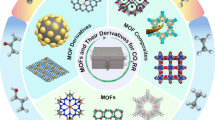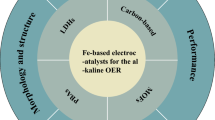Abstract
The electrochemical reduction of 9,10-anthraquinone (AQ) was investigated in CH3CN in both the absence and presence of the hydrogen-bond and proton donating additives, CH3OH, CH(CF3)2OH, phenol, 4-methoxyphenol, 4-cyanophenol, 2,4,6-trichlorophenol, and benzoic acid (BA). Three clearly different types of electrochemical behavior were observed with increasing concentrations of the additives, and were simulated to analyze the reaction mechanisms. Type I was observed for weakly interacting additives, such as CH3OH, characterized by positive shifts of the two well-separated reduction waves, corresponding to the formation of AQ•− and AQ2−, with no loss of reversibility. The second wave shifted more strongly, and finally merged with the first. These behaviors are explained by the association of AQ2− with the additives via strong hydrogen-bonding. Type II is attributed to a reduction mechanism involving quantitative formation of strong hydrogen-bonded complexes of AQ2− with additives, such as CH(CF3)2OH, phenol and 4-methoxyphenol, showing a reversible or quasireversible two-electron reduction wave with increasing concentrations of the additives. The behavior of Type III, observed in the presence of strongly interacting additives, such as 2,4,6-trichlorophenol and BA, is characterized by a voltammogram composed of the 2-electorn cathodic and the broad anodic waves without keeping reversibility, facilitated by proton transfer in the hydrogen-bonded complexes, AQ•−-BA and AQ2−-BA. The effects of hydrogen-bonding and protonation on the electrochemistry of AQ have been systematically demonstrated in terms of the potentials and reaction pathways of the various species, which appear in quinone-hydroquinone systems.
Similar content being viewed by others
References
J. Q. Chambers, “The Chemistry of the Quinoid Compounds,” ed. S. Patai and Z. Rappoport, 1988, Vol. II, Chap. 12, Wiley, New York, 719 – 757; 1974, Vol. I, Chap. 14, Wiley, New York, 737 – 791.
M. E. Peover, “Electroanalytical Chemistry”, ed. A. J. Bard, 1967, Dekker, New York, 1 – 51.
A. J. Swallow, “Function of Quinones in Energy Conserving Systems,” ed. B. L. Trumpower, 1982, Chap. 3, Academic Press, New York.
M. Y. Okamura and G. Feher, Annu. Rev. Biochem., 1992, 61, 861.
A. Niemz and V. M. Rotello, Acc. Chem. Res., 1999, 32, 44.
B. Uno, A. Kawabata, and K. Kano, Chem. Lett., 1992, 1017.
B. Uno, N. Okumura, M. Goto, and K. Kano, J. Org. Chem., 2000, 65, 1448.
N. Gupta and H. Linschitz, J. Am. Chem. Soc., 1997, 119, 6384.
N. Okumura and B. Uno, Bull. Chem. Soc. Jpn., 1999, 72, 1213.
Y. Ge. L. Miller, T. Ouimet, and D. K. Smith, J. Org. Chem., 2000, 65, 8831.
M. Gómez, F. J. Conzález, and I. González, Electroanalysis, 2003, 15, 635.
J. Garza, R. Vargas, M. Gómez, I. González, and F. J. Conzález, J. Phys. Chem. A, 2003, 107, 11161.
M. Gómez, F. J. Conzález, and I. González, J. Electrochem. Soc., 2003, 150, E527.
N. A. Macías-Ruvalcaba, I. González, and M. Aguilar-Martínez, J. Electrochem. Soc., 2004, 151, E110.
M. Gómez, F. J. Conzález, and I. González, J. Electroanal. Chem., 2005, 578, 193.
I. M. Kolthoff and J. J. Lingane, “Polarograhpy,” 2nd ed., 1952, Vol. 1, Chaps. 14 and 15, Interscience, New York.
N. A. Macías-Ruvalcaba, N. Okumura, and D. H. Evans, J. Phys. Chem. B, 2006, 110, 22043.
P. H. Give and M. E. Peover, J. Chem. Soc., 1960, 358.
I. M. Kolthoff and T. B. Reddy, J. Electrochem. Soc., 1961, 108, 980.
M. Huynh and T. Meyer, Chem. Rev., 2007, 5004.
J. W. Lown, Chem. Soc. Rev., 1993, 165.
J. W. Lown, “Anthracycline and Anthracenedione-based Anticancer Drugs,” 1988, Elsevier, Amsterdam.
T. Kubota, K. Kano, B. Uno, and T. Konse, Bull. Chem. Soc. Jpn., 1987, 60, 3865.
B. Uno, K. Kano, T. Konse, T. Kubota, S. Matsuzaki, and A. Kuboyama, Chem. Pharm. Bull., 1985, 33, 5155.
M. D. Liptak, K. C. Gross, P. G. Seybold, S. Feldgus, and G. C. Shieds, J. Am. Chem. Soc., 2002, 124, 6421.
E. P. Serjeant and B. Dempsey, “IUPAC Chem Data Ser. No. 23. NY,” 1979, Pergamon, NY, 989.
M. H. Abraham, P. P. Duce, D. G. Barratt, J. J. Morris, and P. Taylor, J. Chem. Soc., Perkin Trans. 2, 1989, 1355.
P. J. O’Malley, J. Phys. Chem. A, 1997, 101, 6334.
K. Takamura and Y. Hayakawa, Anal. Chim. Acta, 1968, 43, 273.
K. Takamura and Y. Hayakawa, J. Electroanal. Chem., 1971, 31, 225.
T. Fuse, F. Kusu, and K. Takamura, J. Chromatogr., A, 1997, 764, 177.
K. B. Pate and R. L. Willson, J. Chem. Soc., Faraday Trans. 1, 1973, 69, 814.
S. I. Bailey and I. M. Ritchie, Electrochim. Acta, 1985, 30, 3.
S. I. Bailey and I. M. Ritchie, J. Chem Soc., Faraday Trans. 2, 1983, 645.
Author information
Authors and Affiliations
Corresponding author
Rights and permissions
About this article
Cite this article
Katsumi, J., Nakayama, T., Esaka, Y. et al. Mechanistic Study on the Electrochemical Reduction of 9,10-Anthraquinone in the Presence of Hydrogen-bond and Proton Donating Additives. ANAL. SCI. 28, 257–265 (2012). https://doi.org/10.2116/analsci.28.257
Received:
Accepted:
Published:
Issue Date:
DOI: https://doi.org/10.2116/analsci.28.257




